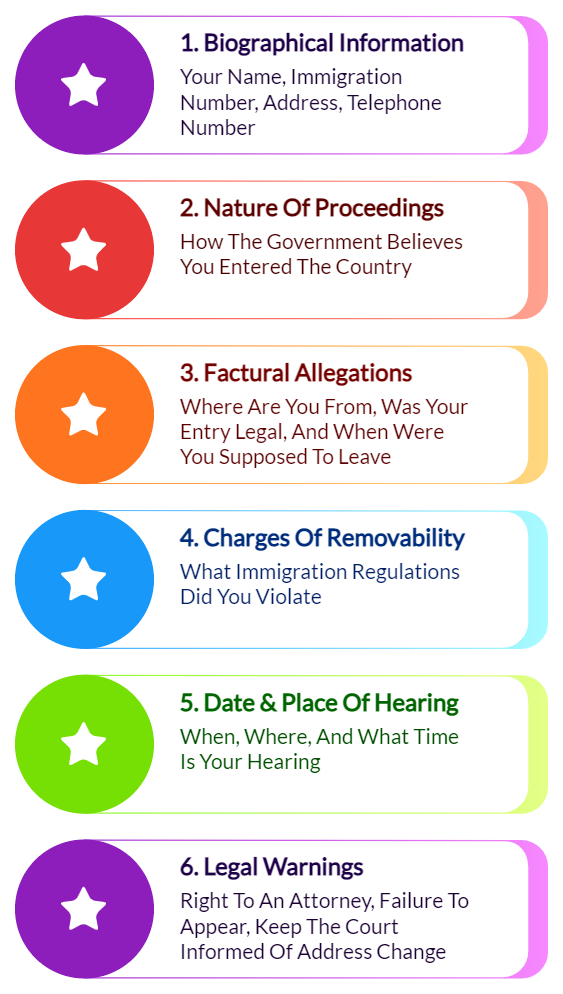
Table Of Contents
- What Is A Notice To Appear?
- Who Can Be Served A Notice To Appear?
- Who Issues The Notice To Appear At Immigration Court?
- What Does The Notice To Appear Tell You? (Six Points You Must Understand.)

What Is A Notice To Appear?
A Notice To Appear, referred to as an NTA, is a document which begins the process to deport that person from the United States. Once you are served with an NTA, you are required (1) to attend a hearing at Immigration Court (2) on the date and time specified and (3) address allegations of removability lodged against you by the U.S. government.
Who Can Be Served A Notice To Appear?
A Notice To Appear may be served on either a lawful permanent resident, an immigrant with a temporary visa, or an undocumented immigrant. Generally, it is served on an individual in person. But it is often served via regular U.S. mail delivery to an immigrant or his attorney.
Who Issues The Notice To Appear At Immigration Court?
A Notice To Appear is issued by the Department of Homeland Security (DHS). Three agencies within DHS are responsible for issuing NTAs: the U.S. Immigration and Customs Enforcement (ICE), the U.S. Citizenship and Immigration Services (USCIS) and the U.S. Customs and Border Protection (CBP).
Historically, ICE, being the arm of DHS which conducts homeland security investigations as well as immigration enforcement and removal operations, and CBP, which oversees activities at ports of entry and manages customs, immigration, security, and agricultural inspections, have issued the vast majority of NTAs on immigrants.
More recently, NTAs issued by USCIS, after the denial of an immigration benefit, such as permanent residence or citizenship, has taken on heightened significance, following new rules promulgated by the Trump Administration.
What Does The Notice To Appear Tell You? (Six Points You Must Understand.)
The Notice To Appear is a short two-page document with six sections. Each section has important information about you and your case. To defend yourself against deportation, it is critical for you to understand and critically analyze each section.

1. Biographical Information
The first part of the NTA lists your name, any other names you have used, your alien registration number, your current address, and your telephone number.
You should review this information carefully. A wrong alias, misspelling of your name, or incorrect address could lead to problems in your case.
2. Nature Of Proceedings
This section of the NTA provides three options. DHS will mark the box that describes how the government believes you entered the country. This affects what type of relief you can seek to defend against deportation.
- You Are An Arriving Alien. This means you were stopped at the border or port of entry and have not been legally admitted to the U.S.
- You Are An Alien Present In The U.S. Who Has Not Been Admitted Or Paroled. This box classifies you as an immigrant who entered the U.S. without inspection and admission by an immigration officer.
- You Have Been Admitted To The U.S. But You Are Removable For The Reasons Stated Below. This box pertains to immigrants who legally entered but overstayed their visas and lawful permanent residents who have been convicted of committing a crime
If either of the first two boxes are checked, an immigrant will be charged with a violation of inadmissibility under Immigration and Nationality Act section 212.
If the third box is checked, the immigrant will be charged with a violation of deportability under Immigration and Nationality Act section 237.
This video discussed these aspects of the Notice of Appear in more detail.
3. Factual Allegations
The factual allegations usually indicate you are not a U.S. citizen, your home country, the date and place of your entry, and if your entry was authorized, when that period ended. you are whether you are a citizen of the U.S. or some other country, when you came to the U.S., and why you came to the U.S.
4. Charges Of Removability
In this section of the Notice To Appear, DHS lists the reason(s) they seek to deport you and the specific section of immigration law the government asserts you have violated.
A Note Of Caution: At your Master Calendar Hearing, the immigration judge will ask you to admit or deny each of the factual allegations and the removability charges.
If you concede the removability charges, you will be required to inform the judge what defenses you plan to present in your favor.
It is not in your best interests to go to Immigration Court without an attorney. Figuring out your best options for success is no easy task. Winning is even harder.
Recent studies have shown 57% of immigrants go to Immigration Court without a lawyer. Of those who went alone, only 20% were able to win their cases.
5. Date And Place Of Immigration Court Proceedings
At the bottom of the first page of the NTA, you will be provided with the date, time, and location of your first hearing at immigration court. This aspect of notices to appear was the relatively recent subject of a groundbreaking immigration appeals decision.
In the past, the government would often leave this section blank or simply mark it as “to be determined”. A follow up notice – sometimes a few weeks, sometimes a few months later – would be mailed by the immigration court confirming the hearing date, time, and location.
The Supreme Court struck down the constitutionality of such blank NTAs, in Periera v. Sessions, lacking specific case information.
6. Legal Warnings And Certificate Of Service
On the second page, the Notice To Appear provides important warnings about the right to an attorney, the consequences of failing to appear, the duty to inform the court of any address changes, and the duty to surrender if ordered deported or to voluntarily leave the U.S. if so allowed.
In particular, failing to appear at an immigration court hearing will lead to an in absentia deportation order.
Ready to take a serious and honest look at the strengths and weaknesses of your immigration case? Let’s get started with a personalized strategy and planning consultation . . .




